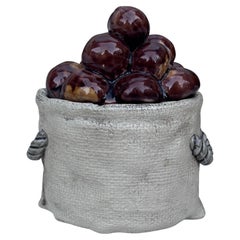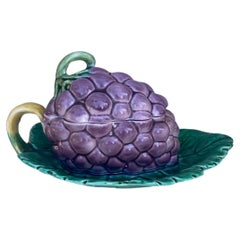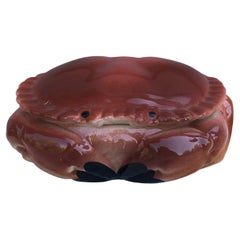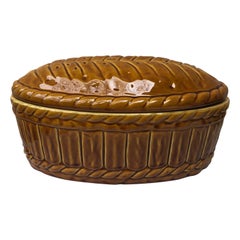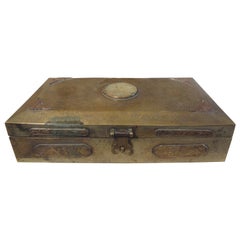Texas - Boxes
to
13
324
5
4
32
165
127
9
57
37
17
24
3
11
10
2
18
2
3
3
2
16
13
7
5
4
4
4
4
3
3
3
1
1
1
1
149
127
92
42
33
333
5,260
4,656
220
121
60
42
38
Height
to
Width
to
333
329
329
8
7
6
5
4
Item Ships From: Texas
19th Century Majolica Trompe L'oeil Chestnut Tureen Sarreguemines
By Sarreguemines
Located in Austin, TX
19th Majolica chestnut tureen signed Sarreguemines.
rare Bag trompe L'oeil.
Category
1890s French Country Antique Texas - Boxes
Materials
Ceramic
Majolica Grapes Tureen Sarreguemines, circa 1930
By Sarreguemines
Located in Austin, TX
Majolica grapes tureen Sarreguemines, circa 1930.
Category
1930s French French Provincial Vintage Texas - Boxes
Materials
Ceramic
19th Century Bohemian Moser Attrib Enameled Ormolu Jewel Casket Table Box
Located in Forney, TX
A rare and exceptional Aesthetic Movement period Bohemian enameled jewel casket attributed to luxury glassmaker Moser.
Hand-crafted in the late 19th cent...
Category
19th Century European Aesthetic Movement Antique Texas - Boxes
Materials
Metal, Ormolu
Majolica Crab Tureen Caugant, circa 1950
By Michel Caugant
Located in Austin, TX
Vintage French Majolica crab tureen signed Caugant, circa 1950.
Category
1950s French Mid-Century Modern Vintage Texas - Boxes
Materials
Ceramic
$330 / item
Large Majolica Pate Tureen Caugant Circa 1950
By Michel Caugant
Located in Austin, TX
Large Majolica Pate Tureen signed Caugant Circa 1950.
Category
1950s French Rustic Vintage Texas - Boxes
Materials
Ceramic
Antique Chinese Brass Box with Jade Medallion
Located in Houston, TX
Antique Chinese brass decorative box with Jade Medallion. This stunning Chinese export brass box features a beautiful etched bat design with a central c...
Category
1920s Chinese Chinese Export Vintage Texas - Boxes
Materials
Jade, Brass
Antique French Book Box
Located in Houston, TX
Designed to appear as a stack of books, this box is the perfect place to store your treasures. The hinged box is made of wood, and the books are trimmed in gold paint.
This piece we...
Category
20th Century French Texas - Boxes
Materials
Wood
French Majolica Box with Cyclamens, Circa 1890
Located in Austin, TX
French Majolica box with Cyclamens, Circa 1890.
Category
1890s French Art Nouveau Antique Texas - Boxes
Materials
Ceramic
19th Majolica Parrot Tobacco Jar Onnaing
By Onnaing
Located in Austin, TX
French Majolica tobacco jar with a parrot Onnaing, circa 1880.
Category
1880s French French Provincial Antique Texas - Boxes
Materials
Majolica
French Majolica Yellow Duck Bank, circa 1900
Located in Austin, TX
Antique French Majolica yellow duck money bank, circa 1900.
Category
Early 1900s French Country Antique Texas - Boxes
Materials
Ceramic
19C English Tunbridgeware Tabletop Stationary Box, Micro Mosaic
By Tunbridge Ware
Located in Dallas, TX
Stunning little 19th century tabletop stationary box made of micro-mosaic.
Made in Britain, circa 1870, in Tunbridge Wells, hence these type of works are called Tunbridgeware!
...
Category
Late 19th Century English High Victorian Antique Texas - Boxes
Materials
Boxwood, Ebony, Walnut, Burl
Small Chinese Cloisonne and Hardstone Trinket Box, Republic Period, China
Located in Austin, TX
A lovely small Chinese export cloisonne trinket box with a carved hardstone roundel, Early Republic Period circa 1915, China.
The small cloisonne box set on four short bun feet, and...
Category
1910s Chinese Qing Vintage Texas - Boxes
Materials
Stone, Copper, Enamel
Victorian Era Tramp Art Chip Carved Trunk/ Box with Additional Glove Box
Located in Waxahachie, TX
2 handmade boxes included.
Rare 1800s Tramp Art Lion Door knocker Hand Carved Storage Box / Jewelry Box / Crimson Velvet with Brass Hardware
With intricate and elaborate decoration, ...
Category
19th Century British Folk Art Antique Texas - Boxes
Materials
Brass
$495 Sale Price
44% Off
Antique French Belle Epoch Burlwood Revolving Door Decorative Box
Located in Forney, TX
A charming fine quality antique French demilune decorative box from the late 19th century, finished in stunning rich briar elm burlwood, the half-moon shaped bentwood revolving door table or desk box - jewelry casket - trinket keepsake small cabinet - old fashioned cigarette case, features flower...
Category
Late 19th Century Belle Époque Antique Texas - Boxes
Materials
Bronze, Ormolu
Japanese Edo Period Igarashi School Long Lacquer Box, Tanzaku-Bako
Located in Austin, TX
A stunning Japanese Edo period lacquer tanzakubako, box for poem cards, late 18th-early 19th century, Edo Period, Japan.
Attributed to the Igarashi School, this box is masterfully ...
Category
Early 19th Century Japanese Edo Antique Texas - Boxes
Materials
Mother-of-Pearl, Lacquer
Majolica Cottage Money Bank Box, Circa 1900
Located in Austin, TX
Majolica cottage Money Bank Box, Circa 1900.
Category
Early 1900s French French Provincial Antique Texas - Boxes
Materials
Ceramic
Japanese Cloisonne Round Box with Fan Design, Meiji Period, c. 1900, Japan
Located in Austin, TX
A very attractive Japanese red ground cloisonne round box and cover featuring a design of fans, Meiji Period, circa 1900, Japan.
The round cloison...
Category
Early 1900s Japanese Meiji Antique Texas - Boxes
Materials
Copper, Enamel
Mid-19th Century French Oval Pigskin Leather Hat Box with Original Top Hat
Located in Dallas, TX
This exquisite, antique pigskin hat box was crafted in Rouen France, circa 1870. This leather box with brass bottom, features leather straps and handle embellished with decorative br...
Category
Mid-19th Century French Antique Texas - Boxes
Materials
Brass
Chinese Cloisonne Double Peach Box, Republic Period, early 20th century, China
Located in Austin, TX
A lovely Chinese turquoise ground cloisonne "double peach" box and cover with shaped hardwood stand, Republic Period (1911 to 1949), early 20th century, China.
The box formed as a p...
Category
Early 20th Century Chinese Qing Texas - Boxes
Materials
Copper, Enamel
Small Chinese Black Cloisonne Box, Late Qing Dynasty, circa 1900, China
Located in Austin, TX
A small and lovely Chinese black ground cloisonne box with peony design, late Qing Dynasty, circa 1900, China.
The small cloisonne box raised on four bun feet, and decorated with a design of blossoming peony against a black enamel ground inlaid with geometric wire work in the "wan" pattern.
The large blooms of peony depicted in pleasing shades of red, pink, and yellow enamel, with leaves of dark and light green enamel. The colored enamels pop against the black cloisonne...
Category
Early 1900s Chinese Qing Antique Texas - Boxes
Materials
Copper, Enamel
Exceptional French 17th Century Marriage Trunk
Located in Round Top, TX
An exceptional 17th century Marriage Trunk - Malle - from the Provence region of France. Soundly constructed from wood and clad in leather. Beautifully ...
Category
17th Century French Antique Texas - Boxes
Materials
Leather
18th Century Italian Painted and Parcel Gilt Reliquary Box
Located in Houston, TX
18th century Italian painted and parcel gilt reliquary box.
This lovely large Italian Baroque box is made of painted and parcel gilt wood surrounded by ...
Category
18th Century Italian Baroque Antique Texas - Boxes
Materials
Glass, Wood
Hand Painted Faux Onyx Box by Maitland Smith
By Maitland Smith
Located in Denton, TX
Hand painted Faux onyx Maitland Smith decorative box with hinged lid and brass feet. Wonderful brush work make this quite the decorative ite...
Category
20th Century Philippine Texas - Boxes
Materials
Brass
Fine 19th Century French Gilt Bronze and Cut Crystal Tantalus
Located in Dallas, TX
19th century French bronze & glass tantalus set with (4) gold decorated glass decanters with (14) cordials glasses in fitted bronze insert set...
Category
Late 19th Century French Louis XV Antique Texas - Boxes
Materials
Bronze
Chinese Yellow Cloisonne Dragon Box, Republic Period, circa 1920, China
Located in Austin, TX
A charming Chinese yellow cloisonne small trinket box with dragons, Republic Period, circa 1920, China.
The small box sets on four bun feet and designed ...
Category
1920s Chinese Qing Vintage Texas - Boxes
Materials
Copper, Enamel
Emerald & Ruby Mounted Silvered Filigree Box
Located in Austin, TX
Immaculately crafted from the 20th century, this Silvered Filigree Box exhibits the skill of fine craftsmanship and gemstone mastery. This breath...
Category
Late 20th Century Tibetan Tibetan Texas - Boxes
Materials
Metal
$1,400 Sale Price
33% Off
Vintage Tibetan Style Dragon Stacking Picnic Box, Painted Wood, 1990's, China
Located in Austin, TX
A highly decorative vintage Chinese red painted stacking picnic box and carrier, painted in the Tibetan style, circa 1990's, China.
The large painted and textured wood picnic box and carrier comprised of three trays or boxes, and one lid, all housed in a handled carrier. The red painted boxes and cover stack.
A large roundel design of a golden dragon face within a cloud collar...
Category
1990s Chinese Tibetan Texas - Boxes
Materials
Wood
Surrealist Style Carved Wood Decorative Box
Located in Houston, TX
Surrealist Style Carved Wood Decorative Box.
This lovely decorative box is hand carved and quite interesting. Great coffee table or bookcas...
Category
20th Century Mid-Century Modern Texas - Boxes
Materials
Wood
18th Century Small Black Jewelry Chest
Located in Dallas, TX
This old wooden chest was probably a jewelry box back in the day. It was painted in black then hand painted with decor and organic forms throughout. The two wooden front doors...
Category
18th Century Asian Antique Texas - Boxes
Materials
Wood, Paint
French 17th Century Leather Box, Coffre
Located in Round Top, TX
A very charming late 17th century French Coffre - Box crafted from beautifully patina'd leather. A wonderful piece to serve as a jewelry box or to adorn any table top.
Category
17th Century French Antique Texas - Boxes
Materials
Leather
Tortoiseshell Tea Caddy With Sunburst Design
Located in Dallas, TX
Circa 1870, English tortoiseshell tea caddy with sunburst design. It is absolutely the finest one I’ve ever owned! No cracks no restoration absolutely mint.
Category
1870s English Antique Texas - Boxes
Materials
Tortoise Shell
Italian 17th Century Primitive Collection Box
Located in Round Top, TX
A rare and unique church collection box from Northern Italy. Beautifully constructed from thick planks of walnut with intriguing carving detail. A wonde...
Category
Mid-17th Century Italian Antique Texas - Boxes
Materials
Walnut
Mid-Century French Yellow Marble and Chrome Jewelry Box Casket
Located in Dallas, TX
Keep your jewelry safe in this elegant antique marble box. Created in France circa 1950, the casket sits on small square feet. The top open and re...
Category
Mid-20th Century French Texas - Boxes
Materials
Marble, Chrome
Small Japanese Lacquer Duck Incense Box, Kogo, Meiji Period, Late 19th Century
Located in Austin, TX
An exquisite Japanese Meiji Period small lacquer incense box, kogo, in the form of a duck or goose, late 19th century, Japan.
The delicate lacquer box, known as a kogo in Japanese, ...
Category
Late 19th Century Japanese Meiji Antique Texas - Boxes
Materials
Lacquer
19th Century French Large and Finely Gilt Bronze Casket
Located in Dallas, TX
Finest quality French 19th century bronze doré box. Beautiful scenes of cherubs at play on all sides. Boucher scenes. Lined with a beautiful silk original key.
Category
Mid-19th Century French Louis Philippe Antique Texas - Boxes
Materials
Bronze
Early 18th Century Louis XVI Kingwood Small Chest
Located in Dallas, TX
A Louis XVI kingwood small chest with brass mounts. Opens to a metal lined interior and two velvet working lower drawers. Circa 1700, France.
Category
Early 1700s French Louis XVI Antique Texas - Boxes
Materials
Metal, Brass
Antique Painted Table Coffer, Dated 1915
Located in Dallas, TX
A rather unique painted chest from Europe, this table coffer was commissioned in 1915. The right side (when viewing from the front) is dated, with the numbers flanking a springing ra...
Category
Early 20th Century European Renaissance Texas - Boxes
Materials
Wood, Paint
Spanish Colonial Era 18th/19th Century Inlaid Cedar Wooden Chest Box Trunk
Located in Forney, TX
A charming scarce Spanish Colonial era parquetry inlaid cedar legged storage chest (large table box / small trunk) with nicely aged warm rich dark patina. circa 1790
Rustic handmade...
Category
18th Century Spanish Colonial Antique Texas - Boxes
Materials
Iron
Chinese Canton Enamel Round Stacking Boxes and Cover, circa 1900, China
Located in Austin, TX
An absolutely lovely Chinese export pink Canton enamel round stacking box and cover, late Qing Dynasty, circa 1900, China.
The circular stacking box consists of a bowl form base, ...
Category
Early 1900s Chinese Qing Antique Texas - Boxes
Materials
Copper, Enamel
Mid-19th Century French Oval Pigskin Leather Hat Box with Original Top Hat
Located in Dallas, TX
This exquisite, antique pigskin box was crafted in Rouen France, circa 1870. This leather box features leather straps and handle embellished with decorativ...
Category
Mid-19th Century French Antique Texas - Boxes
Materials
Brass
Wrought Iron Lock Box
Located in Round Top, TX
Very nice wrought iron lock box with lock and key. Great quality.
Category
1920s Italian Vintage Texas - Boxes
Materials
Wrought Iron
$1,450
Russian Hand Painted Lacquerware Palekh Miniature Table Box
Located in Forney, TX
A rare and exceptional finely painted vintage Imperial Russian lacquerware box.
Exquisitely hand-crafted in the Palekhsky District (Палех) of wes...
Category
20th Century Russian Folk Art Texas - Boxes
Materials
Lacquer
Mid-19th Century French Leather Bound Book Box with Six Old Fashioned Glasses
Located in Dallas, TX
For a interesting bar accessory, look no further than this colorful antique Faux-book "Cave à Liqueur". Crafted in France, circa 1860, the liquor box is shaped like four antique book...
Category
Mid-19th Century French Antique Texas - Boxes
Materials
Leather, Glass
XVIIIth Century Inspired Handpainted Manila Small Coffer with Oriental Influence
By Alfonso Marina
Located in Bosques de las Lomas, MX
Our stunning Manila small coffer has colorful and intricate hand-painted scenes the immediately grab your attention. It is inspired by similar pieces from...
Category
21st Century and Contemporary Mexican Texas - Boxes
Materials
Brass
19th Century French Louis XV Carved Walnut Wall Panetière Cabinet from Provence
Located in Dallas, TX
This beautiful antique fruitwood hanging panetière was crafted in Provence, circa 1830. This decorative cabinet stands on scrolled escargot feet over a intricate scalloped apron; it ...
Category
Early 19th Century French Louis XV Antique Texas - Boxes
Materials
Walnut
19c Anglo Indian Highly Carved Teak and Sandalwood Sarcophagus Sewing Box
Located in Dallas, TX
PRESENTING A VERY NICE 19C Anglo Indian Highly Carved Teak and Sandalwood Sarcophagus Sewing Box.
Made in Bombay, India circa 1890-1900.
The box case/body is made of sandalwood wit...
Category
Late 19th Century Indian Anglo-Indian Antique Texas - Boxes
Materials
Bone, Sandalwood, Teak
19th Century Italian Baroque Parcel Gilt and Hand Painted Table Box Casket
Located in Dallas, TX
Decorate a coffee table or a shelf with this elegant and colorful casket. Crafted in Italy circa 1880, the Venetian box stands on heavily carved feet decorated with gilt acanthus lea...
Category
Late 19th Century Italian Baroque Antique Texas - Boxes
Materials
Oak
Mid-19th Century Italian Carved and Painted Decorative Box
Located in Dallas, TX
This elegant antique box was crafted in Italy, circa 1850. The colorful, detailed box features hand painted scenes of people with horses and butterflies. The rectangular box has its ...
Category
Mid-19th Century Italian Antique Texas - Boxes
Materials
Pine
Early 20th Century French Repousse Brass and Wooden Firewood Box on Wheels
Located in Dallas, TX
Crafted in France, circa 1920, the antique wood and brass fireplace wood coffer stands on casters; the trunk is decorated with repousse tavern scene motifs in the manner of David Ten...
Category
Early 20th Century French Napoleon III Texas - Boxes
Materials
Brass
Green Tortoiseshell Tea Caddy
Located in Dallas, TX
Green tortoiseshell tea caddy from England. With two interior covers raised on four silver ball feet. Circa 1870.
Category
1870s English Antique Texas - Boxes
Materials
Silver
18th Century Distressed Swedish Wedding Box
Located in Houston, TX
This late 18th-century Swedish wooden box is a captivating piece that effortlessly transports us to a bygone era. Crafted in Sweden during the final decade of the 18th century, it ex...
Category
18th Century Swedish Rustic Antique Texas - Boxes
Materials
Metal
Pair of Mid-Century English Hand Painted Tole Tea Boxes with Bird Decor
Located in Dallas, TX
Decorate a kitchen cabinets with this pair of colorful tea boxes. Crafted in England circa 1950, and built of tinned metal, each decorative box with attached lid, is hand painted wit...
Category
Mid-20th Century English Texas - Boxes
Materials
Metal
19th Century English Victorian Copper and Brass Coal Bucket
Located in Dallas, TX
This antique coal scuttle was created in England, circa 1880. Built of copper with a brass and turned walnut handle, the oblong bucket stands on a round base. The versatile decorativ...
Category
Mid-19th Century English Antique Texas - Boxes
Materials
Brass, Copper
Tortoiseshell Tea Caddy With Inlaid Mother Of Pearl
Located in Dallas, TX
Tortoiseshell tea caddy with inlaid mother of pearl from England. Metal lined under two lids. Excellent condition, circa 1860.
Category
1860s English Antique Texas - Boxes
Materials
Tortoise Shell, Mother-of-Pearl
Carved Leather Dome Top Box
Located in Dallas, TX
Leather carved dome top box with warrior. Red silk interior. Spain, 19th century.
Category
1890s Spanish Antique Texas - Boxes
Materials
Leather, Silk
19th Century French Silvered Bronze Casket with Hunt Animals Signed A. Cain
Located in Dallas, TX
Decorate a shelf or a lady's bathroom counter with this exquisite jewelry case box. Crafted in France circa 1880 and oblong in shape, the bronze casket stands on openwork plant form ...
Category
Late 19th Century Antique Texas - Boxes
Materials
Bronze
19th Century Italian Ruby Glass Box with Miniature of Basilica
Located in Dallas, TX
Lovely little 19th century ring jar or pill box made of a thick wine colored ruby glass.
It has a miniature of a Basilica on top, gilt metal mounts with beautiful filigree on the si...
Category
Early 19th Century Vatican Grand Tour Antique Texas - Boxes
Materials
Metal
19th Century Majolica Box Books Choisy Le Roi
By Choisy-le-Roi
Located in Austin, TX
Rare 19th Century Majolica Box Books Choisy Le Roi.
H / 6.8 inches
Category
1880s French Rustic Antique Texas - Boxes
Materials
Ceramic, Majolica
19th Century French Burl Elm Inlaid Jewelry Box with Drawer & Inside Mirror
Located in Dallas, TX
Decorate a coffee table or a shelf with this elegant antique box. Created in France circa 1880, the rectangular cabinet is decorated with an elegant floral inlaid star motif on the t...
Category
Late 19th Century French Napoleon III Antique Texas - Boxes
Materials
Mercury Glass, Elm, Burl
French Green Glass Cabbage Box, Circa 1960
Located in Austin, TX
French green glass cabbage box, Circa 1960.
Category
1960s French Rustic Vintage Texas - Boxes
Materials
Glass
Recently Viewed
View AllMore Ways To Browse
Khatam Box
Moroccan Bone Box
Rosenthal Lidded Box
Lacquer Cigarette Case
Letter Post Box
Limoges Porcelain Eggs
Moorish Mother Of Pearl Box
Oriental Vanity
Regency Sewing Box
Russian Lacquer Box
Shaving Box
Antique Glass Trinket Box With Lid
Antique Indian Brass Plate
Antique Iron Strongbox
Antique Silk Top Hat
Antique Straw Box
Bone Casket
Bone Inlay Vanity
